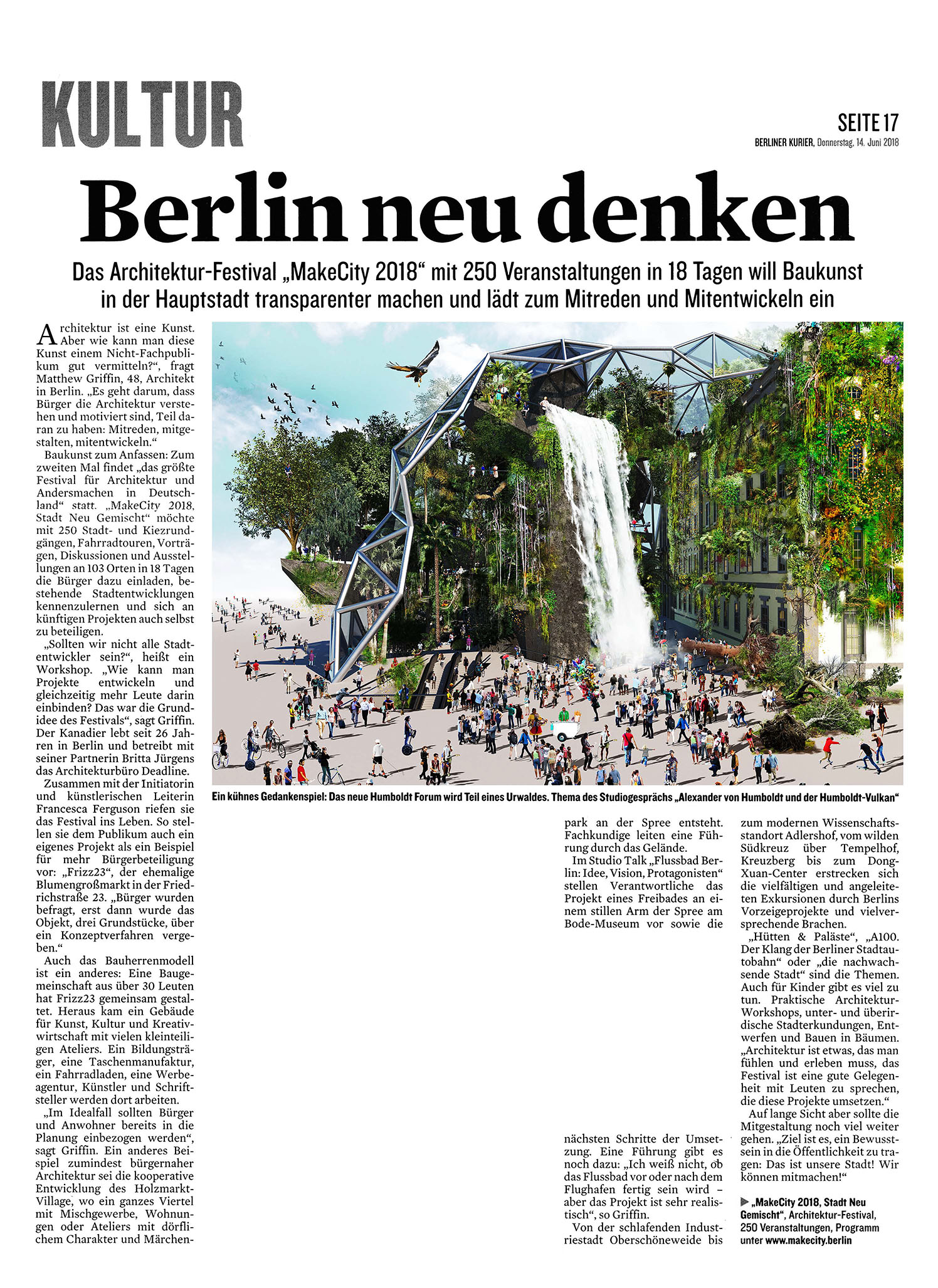The “MakeCity 2018” Architecture Festival with 250 events in 18 days aims to make architecture in Berlin more transparent and invites people to join in the conversation and help develop it.
A bold thought experiment: the new Humboldt Forum will become part of a primeval forest.
Topic of the studio talk “Alexander von Humboldt and the Humboldt Volcano”.
Publication Rethinking Berlin @ Berliner Kurier, Berlin, 14 June 2018
Rethinking
Berlin
Architecture is an art. But how can you communicate this art well to a non-specialist audience?” asks Matther Griffin, 48, an architect in Berlin. “It’s about citizens understanding architecture and being motivated to have a part in it: To have a say, to co-design, to co-develop.”
Building art to touch: For the second time, “the largest festival for architecture and. MakeCity 2018, Stadt Neu Gemischt” (MakeCity 2018, City Newly Mixed) will take place for the second time. With 250 city and neighbourhood tours, bicycle tours, lectures, discussions and exhibitions at 103 locations over 18 days, the festival invites citizens to get to know existing urban developments and to participate in future projects themselves. “Shouldn’t we all be urban developers?” is the title of one workshop.
“How can we develop projects and involve more people in them at the same time? That was the basic idea of the festival,” says Griffin. The Canadian has lived in Berlin for 26 years and runs the architecture firm Deadline with his partner Britta Jürgens. Together with the initiator and artistic director Francesca Ferguson, they brought the festival to life. So they also present their own project to the audience as an example of more citizen participation: “Frizz23”, the former wholesale flower market at Friedrichstraße 23.
“Citizens were consulted, only then was the property, three plots, allocated via a concept procedure.” The developer model is also different: a building community of over 30 people designed together. The result was a building for art, culture and creative industries with many small studios. An educational institution, a bag manufacturer, a bicycle shop, an advertising agency, artists and writers will work there. “Ideally, citizens and residents should already be involved in the planning,” says Griffin.
Another example of at least citizen-oriented architecture is the cooperative development of the Holzmarkt Village, where an entire quarter with mixed businesses, flats or studios with a village character and a fairy-tale park is being built on the Spree. Experts will lead a guided tour of the site. In the Studio Talk “Flussbad Berlin: Idea, Vision, Protagonists”, those responsible present the project of an open-air swimming pool on a quiet arm of the Spree at the Bathing Museum as well as the next steps in its realisation.
There is also a guided tour: “I don’t know whether the Flussbad will be finished before or after the airport – but the project is very realistic,” says Griffin. From the dormant industrial town of Oberschöneweide to the modern science location of Adlershof, from the wild Südkreuz to Tempelhof, Kreuzberg and the Dong Xuan Centre, the diverse and guided excursions through Berlin’s showcase projects and promising brownfields extend. “Huts & Palaces”, “A100. The sound of Berlin’s urban motorway” or “the regrowing city” are the topics. There is also plenty to do for children. Practical architecture workshops, underground and above-ground urban explorations, designing and building in trees.
“Architecture is something you have to feel and experience, the festival is a good opportunity to talk to people who make these projects happen.” In the long run, however, the co-design should go much further. “The goal is to bring an awareness to the public: this is our city! We can participate!”
“MakeCity 2018, City New Mixed”, architecture festival, 250 events, programme at www.makecity.berlin
related PROJECTS
related PRESS
